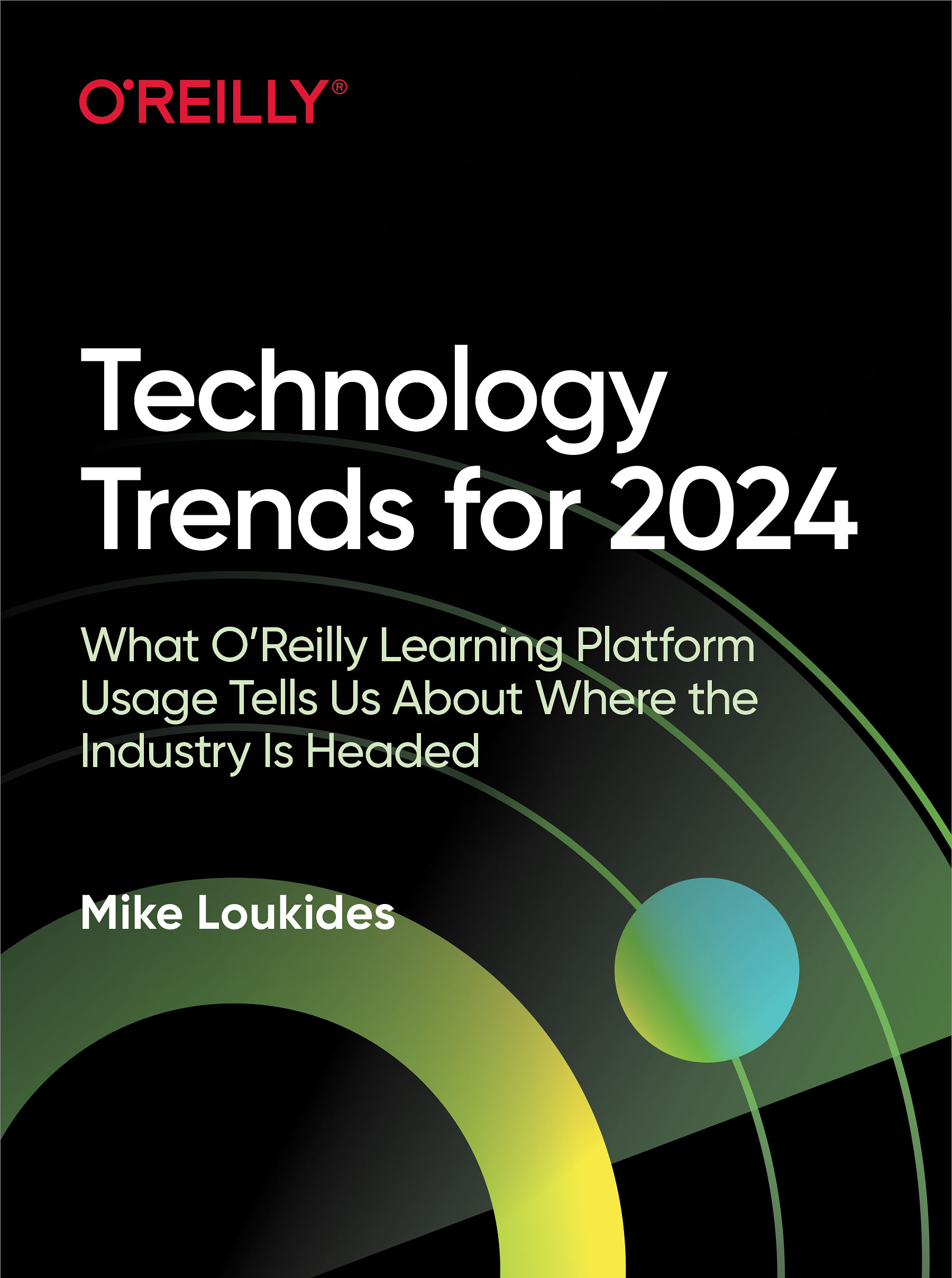This has been a atypical yr. Whilst we adore to discuss how briskly generation strikes, web time, and all that, if truth be told the final main new thought in instrument structure used to be microservices, which dates to kind of 2015. Earlier than that, cloud computing itself took off in kind of 2010 (AWS used to be based in 2006); and Agile is going again to 2000 (the Agile Manifesto dates again to 2001, Excessive Programming to 1999). The cyber web is over 30 years previous; the Netscape browser seemed in 1994, and it wasn’t the primary. We expect the business has been in consistent upheaval, however there were rather few disruptions: one each 5 years, if that.
2023 used to be a type of uncommon disruptive years. ChatGPT modified the business, if now not the sector. We’re skeptical about such things as process displacement, no less than in generation. However AI goes to carry adjustments to just about each side of the instrument business. What is going to the ones adjustments be? We don’t know but; we’re nonetheless at first of the tale. On this document about how persons are the usage of O’Reilly’s studying platform, we’ll see how patterns are starting to shift.
Only a few notes on technique: This document is in accordance with O’Reilly’s interior “Gadgets Considered” metric. Gadgets Considered measures the true utilization of content material on our platform. The information used on this document covers January via November in 2022 and 2023. Every graph is scaled in order that the subject with the best utilization is 1. Subsequently, the graphs can’t be when put next without delay to one another.
Remember the fact that those “gadgets” are “seen” through our customers, who’re in large part skilled instrument builders and programmers. They aren’t essentially following the newest developments. They’re fixing real-world issues for his or her employers. And so they’re choosing up the talents they want to advance of their present positions or to get new ones. We don’t wish to cut price those that use our platform to stand up to hurry on the newest scorching generation: that’s how the business strikes ahead. However to know utilization patterns, it’s necessary to comprehend that each corporate has its personal generation stacks, and that the ones stacks alternate slowly. Corporations aren’t going to throw out two decades’ funding in PHP so they may be able to undertake the newest widespread React framework, which it will likely be displaced through every other widespread framework subsequent yr.
Device Building
Lots of the subjects that fall underneath instrument building declined in 2023. What does this imply? Programmers are nonetheless writing instrument; our lives are increasingly more mediated through instrument, and that isn’t going to switch.
Device builders are answerable for designing and construction larger and extra complicated tasks than ever. That’s one pattern that gained’t alternate: complexity is at all times “up and to the appropriate.” Generative AI is the wild card: Will it lend a hand builders to control complexity? Or will it upload complexity all its personal? It’s tempting to have a look at AI as a handy guide a rough repair. Who needs to be informed about coding practices whilst you’re letting GitHub Copilot write your code for you? Who needs to be informed about design patterns or instrument structure when some AI software would possibly sooner or later do your high-level design? AI is writing low-level code now; as many as 92% of instrument builders are the usage of it. Whether or not it’s going to have the ability to do high-level design is an open query—however as at all times, that query has two facets: “Will AI do our design paintings?” is much less fascinating than “How will AI alternate the issues we wish to design?” And the true query that may alternate our business is “How can we design techniques wherein generative AI and people collaborate successfully?”
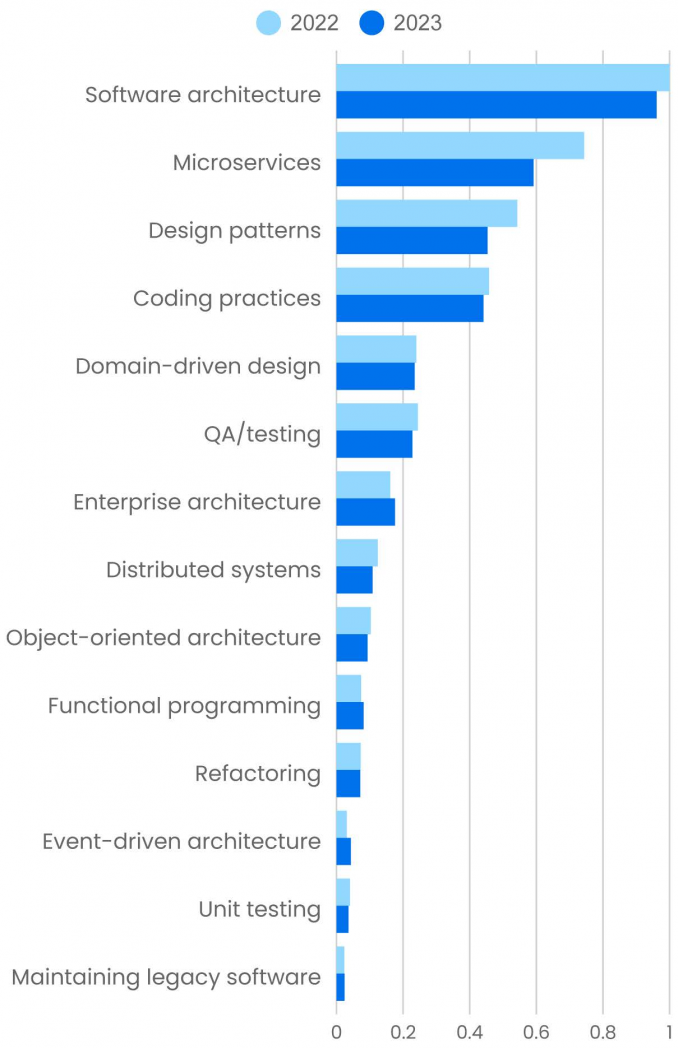
Irrespective of the solutions to those questions, people will want to perceive and specify what must be designed. Our records displays that the majority subjects in instrument structure and design are down year-over-year. However there are exceptions. Whilst instrument structure is down 3.9% (a rather small decline), venture structure is up 8.9%. Area-driven design is especially helpful for working out the habits of complicated venture techniques; it’s down, however handiest 2.0%. Use of content material about event-driven structure is rather small, but it surely’s up 40%. That fluctuate is necessary as a result of event-driven structure is a device for designing massive techniques that experience to ingest records from many alternative streams in genuine time. Practical programming, which many builders see as a design paradigm that may lend a hand resolve the issues of allotted techniques, is up 9.8%. So the instrument building international is converting. It’s transferring towards allotted techniques that organize massive flows of information in genuine time. Use of content material on subjects related to that shift is maintaining its personal or rising.
Microservices noticed a 20% drop. Many builders expressed frustration with microservices throughout the yr and argued for a go back to monoliths. That accounts for the pointy decline—and it’s honest to mention that many organizations are paying the associated fee for transferring to microservices as it used to be “the article to do,” now not as a result of they wanted the dimensions or flexibility that microservices can be offering. From the beginning, microservice proponents have argued that the easiest way to broaden microservices is to begin with a monolith, then damage the monolith into products and services because it turns into vital. If carried out poorly, microservices ship neither scale nor flexibility. Microservices aren’t ultimate for brand spanking new greenfield tasks, until you’re completely positive that you wish to have them from the beginning—or even then, you must consider carefully. It’s certainly now not a generation to enforce simply to observe the newest fad.
Device builders run cold and warm on design patterns, which declined 16%. Why? It most certainly depends upon the wind or the section of the moon. Content material utilization about design patterns higher 13% from 2021 to 2022, so this yr’s decline simply undoes final yr’s achieve. It’s imaginable that working out patterns turns out much less necessary when AI is writing numerous the code for you. It’s additionally imaginable that design patterns appear much less related when code is already in large part written; maximum programmers deal with present packages moderately than broaden new greenfield apps, and few texts about design patterns speak about the patterns which might be embedded in legacy packages. However each tactics of pondering leave out the purpose. Design patterns are not unusual answers to not unusual issues which were seen in observe. Figuring out design patterns helps to keep you from reinventing wheels. Frameworks like React and Spring are necessary as a result of they enforce design patterns. Legacy packages gained’t be stepped forward through refactoring present code simply to make use of some trend, however design patterns are helpful for extending present instrument and making it extra versatile. And, after all, design patterns are utilized in legacy code—even code that used to be written prior to the time period used to be coined! Patterns are came upon, now not “invented”; once more, they’re not unusual answers to issues programmers had been fixing for the reason that starting of programming.
On the similar time, on every occasion there’s a surge of pastime in design patterns, there’s a corresponding surge in trend abuse: managers asking builders what number of patterns they used (as though trend depend have been a metric for excellent code), builders enforcing FactoryFactoryFactory Factories, and the like. What is going round comes round, and the abuse of design patterns is a part of a comments loop that regulates using design patterns.
Programming and Programming Languages
Lots of the programming languages we monitor confirmed declines in content material utilization. Earlier than discussing specifics, even though, we want to have a look at basic developments. If 92% of programmers are the usage of generative AI to jot down code and solution questions, then we’d unquestionably be expecting a drop in content material use. That can or is probably not recommended for profession building, but it surely’s a truth that companies constructed on coaching and studying have to recognize. However that isn’t the entire tale both—and the larger tale leaves us with extra questions than solutions.
Rachel Stephens supplies two interesting items of the puzzle in a fresh article at the RedMonk weblog, however the ones items don’t are compatible in combination precisely. First, she notes the decline in questions requested on Stack Overflow and states (fairly) that asking a nonjudgmental AI assistant may well be a preferable means for newbies to get their questions responded. We agree; we at O’Reilly have constructed O’Reilly Solutions to offer that roughly help (and are within the means of a big improve that may make it much more helpful). However Stack Overflow displays a vast top in questions from 2014 to 2017, with a pointy decline later on; the collection of questions in 2023 is simply 50% of the height, and the 20% decline from the January 2023 report back to the July document is handiest slightly sharper than the former drops. And there used to be no generative AI, no ChatGPT, again in 2017 when the decline started. Did generative AI play a job? It will be silly to mention that it didn’t, however it may well’t be the entire tale.
Stephens issues to every other anomaly: GitHub pull requests declined kind of 25% from the second one 1/2 of 2022 to the primary 1/2 of 2023. Why? Stephens guesses that there used to be higher GitHub process throughout the pandemic and that process has returned to customary now that we’ve (incorrectly) made up our minds the pandemic is over. Our personal idea is that it’s a response to GPT fashions leaking proprietary code and abusing open supply licenses; that would motive programmers to be cautious of public code repositories. However the ones are handiest guesses. This alteration is it sounds as if now not an error within the records. It may well be a one-time anomaly, however no person in reality is aware of the motive. One thing drove down programmer process on GitHub, and that’s inevitably part of the background to this yr’s records.
So, what does O’Reilly’s records say? As it’s been for a few years, Python is essentially the most broadly used programming language on our platform. This yr, we didn’t see an build up; we noticed an overly small (0.14%) decline. That’s noise; we gained’t insult your intelligence through claiming that “flat in a down marketplace” is in reality a achieve. It’s unquestionably honest to invite whether or not a language as widespread as Python has amassed the entire marketplace percentage that it’s going to get. Whilst you’re on the peak of the adoption curve, it’s tricky to move any upper and far more straightforward to drop again. There are at all times new languages in a position to take a few of Python’s marketplace percentage. Probably the most vital alternate within the Python ecosystem is Microsoft’s integration of Python into Excel spreadsheets, but it surely’s too early to be expecting that to have had an impact.
Use of content material about Java declined 14%, an important drop however now not out of line with the drop in GitHub process. Like Python, Java is a mature language and will have nowhere to move however down. It hasn’t ever been “properly cherished”; when Java used to be first introduced, other people walked out of the doorways of the convention room claiming that Java used to be lifeless prior to that you must even obtain the beta. (I used to be there.) Is it time to bounce on Java’s grave? That dance has been happening since 1995, and it hasn’t been proper but.
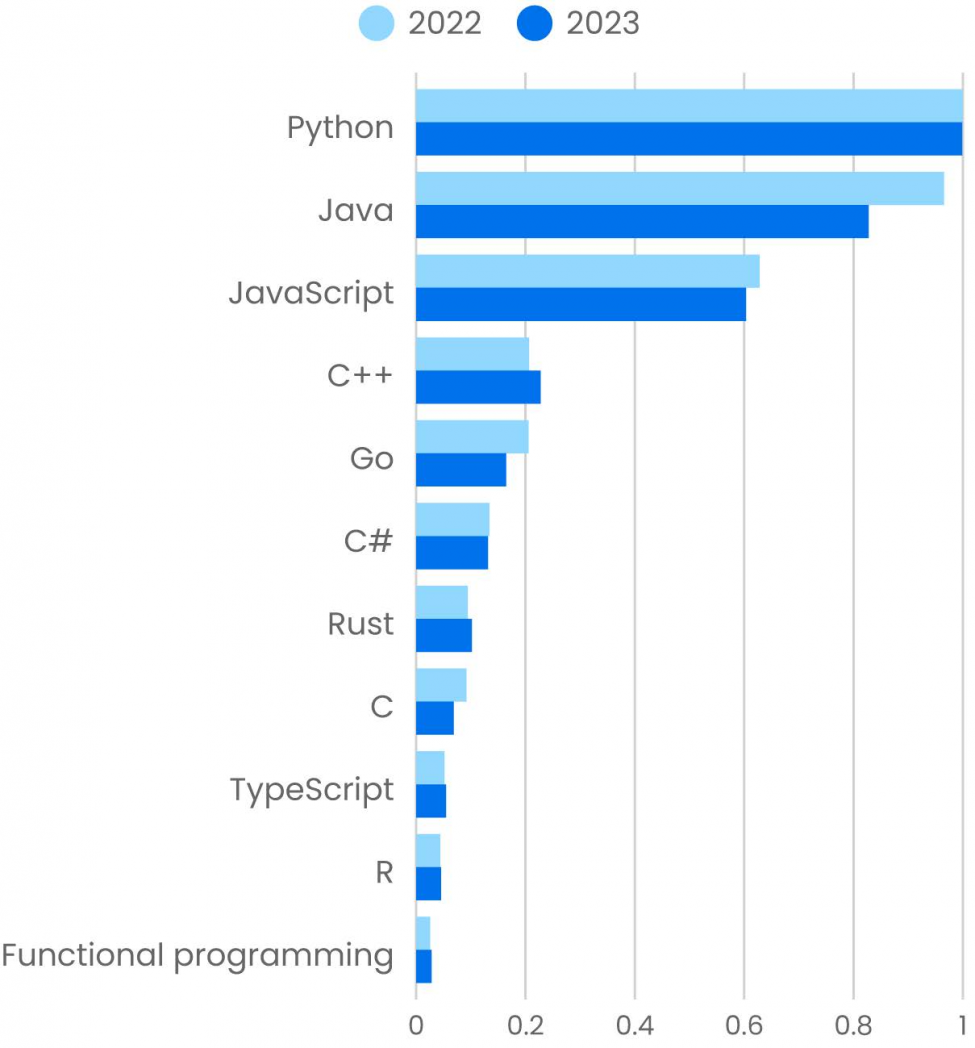
JavaScript additionally declined through 3.9%. It’s a small decline and most certainly now not significant. TypeScript, a model of JavaScript that provides static typing and sort annotations, won 5.6%. It’s tempting to mention that those cancel every different out, however that’s now not proper. Utilization of TypeScript content material is kind of one-tenth the use of JavaScript content material. However it’s proper to mention that pastime in sort techniques is rising amongst cyber web builders. It’s additionally true that increasingly more junior builders use JavaScript handiest via a framework like React or Vue. Boot camps and different crash systems continuously educate scholars in “React,” with little consideration at the larger image. Builders skilled in systems like those would possibly pay attention to JavaScript however would possibly not call to mind themselves as JavaScript builders, and is probably not taking a look to be informed extra concerning the language outdoor of a slender, framework-defined context.
We see enlargement in C++ (10%), which is unexpected for an previous, well-established language. (C++ first seemed in 1985.) At this level in C++’s historical past, we’d be expecting it to be a headache for other people keeping up legacy code, now not a language for beginning new tasks. Why is it rising? Whilst C++ has lengthy been a very powerful language for sport building, there are indicators that it’s breaking out into different spaces. C++ is a perfect language for embedded techniques, which continuously require instrument that runs without delay at the processor (as an example, the instrument that runs in a sensible lightbulb or within the braking machine of any fashionable automotive). You aren’t going to make use of Python, Java, or JavaScript for the ones packages. C++ could also be a very good language for quantity crunching (Python’s numeric libraries are written in C++), which is increasingly more necessary as synthetic intelligence is going mainstream. It has additionally turn into the brand new “should have” language on résumés: understanding C++ proves that you simply’re difficult, that you simply’re a “severe” programmer. Activity nervousness exists—whether or not or now not it’s merited is a unique query—and in an atmosphere the place programmers are frightened about maintaining their present jobs or taking a look ahead to discovering a brand new one, understanding a hard however broadly used language can handiest be an asset.
Use of content material about Rust additionally higher from 2022 to 2023 (7.8%). Rust is a rather younger language that stresses reminiscence protection and function. Whilst Rust is regarded as tricky to be informed, the concept reminiscence protection is baked in makes it a very powerful selection to languages like C++. Insects in reminiscence control are an important supply of vulnerabilities, as famous in NIST’s web page on “More secure Languages,” and Rust does a excellent process of implementing secure reminiscence utilization. It’s now utilized in working techniques (Linux kernel parts), software building, or even venture instrument.
We additionally noticed 9.8% enlargement in content material about purposeful programming. We didn’t see positive aspects for any of the ancient purposeful programming languages (Haskell, Erlang, Lisp, and Elixir) even though; maximum noticed steep declines. Prior to now decade, maximum programming languages have added purposeful options. More recent languages like Rust and Pass have had them from the beginning. And Java has step by step added options like closures in a sequence of updates. Now programmers will also be as purposeful as they wish to be with out switching to a brand new language.
After all, there are some programming languages that we don’t but monitor however that we’re looking at with pastime. Zig is a straightforward crucial language that’s designed to be reminiscence secure, like Rust, however rather simple to be informed. Mojo is a superset of Python that’s compiled, now not interpreted. It’s designed for top functionality, particularly for numerical operations. Mojo’s objective is to facilitate AI programming in one language moderately than a mixture of Python and a few different language (in most cases C++) that’s used for performance-critical numerical code. The place are those languages going? It’s going to be some years prior to they succeed in the extent of Rust or Pass, however they’re off to a excellent get started.
So what does all this let us know about coaching and talent building? It’s simple to suppose that, with Copilot and different equipment to respond to your whole questions, you don’t want to put as a lot effort into studying new applied sciences. All of us ask questions about Google or Stack Overflow, and now we have now different puts to get solutions. Essential as this is, the concept asking questions can exchange coaching is naive. Not like many who’re watching the affect of generative AI on programming, we imagine that it’s going to build up the space between entry-level abilities and senior developer abilities. Being a senior developer—being a senior anything else—calls for a type of fluency that you’ll’t get simply from asking questions. I would possibly by no means be a fluent person of Python’s pandas library (which I used broadly to jot down this document); I requested loads of questions, and that has certainly stored me time. However what occurs after I want to resolve the following drawback? The type of fluency that you wish to have to have a look at an issue and know the way to resolve it doesn’t come from asking easy “How do I do that?” questions. Nor does it preclude asking loads of “I forgot how this serve as works” questions. That’s why we’ve constructed O’Reilly Solutions, an AI-driven carrier that reveals answers to questions the usage of content material from our platform. However experience does require growing the highbrow muscle that comes from grappling with issues and fixing them your self moderately than letting one thing else resolve them for you. (And that comes with forcing your self to keep in mind the entire messy syntax main points.) Individuals who suppose generative AI is a shortcut to experience (and the process name and wage that experience deserves) are shortchanging themselves.
Synthetic Intelligence
In AI, there’s one tale and just one tale, and that’s the GPT circle of relatives of fashions. Utilization of content material on those fashions exploded 3,600% previously yr. That explosion is tied to the semblance of ChatGPT in November 2022. However don’t make the error of pondering that ChatGPT got here out of nowhere. GPT-3 created a large splash when it used to be launched in 2020 (whole with an inept web-based interface). GPT-2 seemed in 2019, and the unique unnumbered GPT used to be even previous. The true innovation in ChatGPT wasn’t the generation itself (even though the fashions at the back of it constitute an important step forward in AI functionality); it used to be packaging the fashion as a chatbot. That doesn’t imply that the GPT explosion wasn’t genuine. Whilst our research of seek developments displays that pastime in ChatGPT has peaked amongst our platform’s customers, pastime in herbal language processing (NLP) confirmed a 195% build up—and from a miles upper place to begin.1 That is smart, given the extra technical nature of our target market. Device builders shall be construction on peak of the APIs for GPT and different language fashions and are most probably much less eager about ChatGPT, the web-based chat carrier. Comparable subjects generative fashions (900%) and Transformers (325%) additionally confirmed large positive aspects. Urged engineering, which didn’t exist in 2022, become an important subject, with kind of the similar utilization as Transformers. So far as overall use, NLP is sort of two times GPT. Then again you wish to have to learn the information, that is AI’s large yr, in large part because of the GPT fashions and the speculation of generative AI.
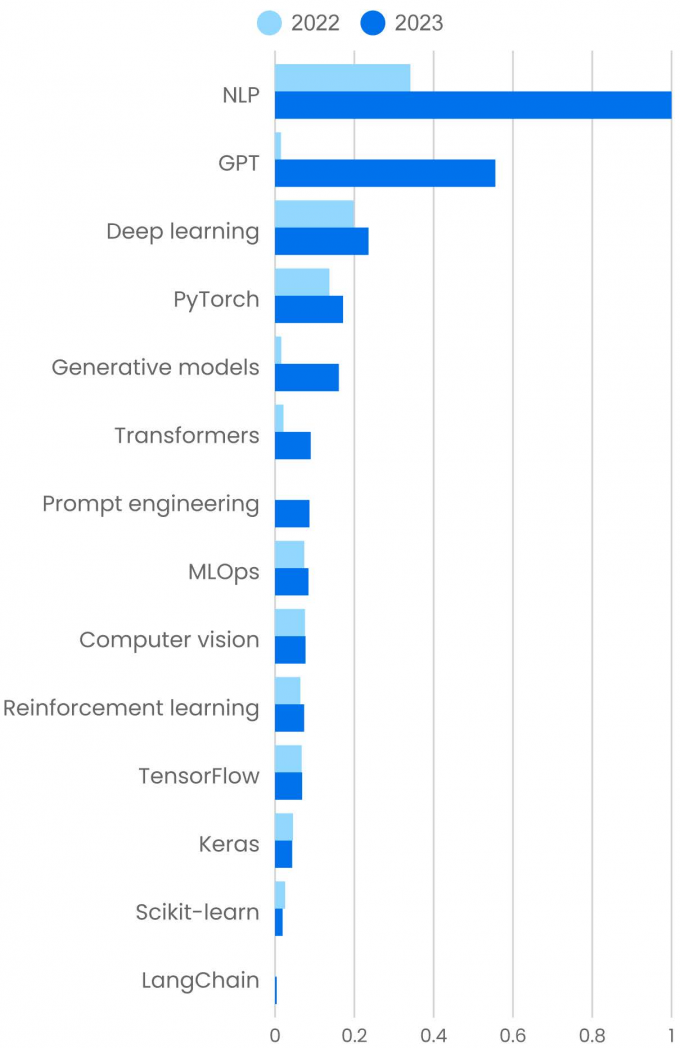
However don’t suppose that the explosion of pastime in generative AI supposed that different sides of AI have been status nonetheless. Deep studying, the introduction and alertness of neural networks with many layers, is key to each side of contemporary AI. Utilization in deep studying content material grew 19% previously yr. Reinforcement studying, wherein fashions are skilled through giving “rewards” for fixing issues, grew 15%. The ones positive aspects handiest glance small compared to the triple- and quadruple-digit positive aspects we’re seeing in herbal language processing. PyTorch, the Python library that has come to dominate programming in system studying and AI, grew 25%. In recent times, pastime in PyTorch has been rising on the expense of TensorFlow, however TensorFlow confirmed a small achieve (1.4%), reversing (or no less than pausing) its decline. Hobby in two older libraries, scikit-learn and Keras, declined: 25% for scikit-learn and four.8% for Keras. Keras has in large part been subsumed through TensorFlow, whilst scikit-learn hasn’t but integrated the features that will make it a excellent platform for construction generative AI. (An try to enforce Transformers in scikit-learn seems to be underway at Hugging Face.)
We’ve lengthy mentioned that operations is the elephant within the room for system studying and synthetic intelligence. Construction fashions and growing packages is difficult and a laugh, however no generation can mature if IT groups can’t deploy, observe, and organize it. Hobby in operations for system studying (MLOps) grew 14% over the last yr. That is cast, considerable enlargement that handiest seems small compared to subjects like generative AI. Once more, we’re nonetheless within the early phases—generative AI and massive language fashions are handiest beginning to achieve manufacturing. If anything else, this build up most certainly displays older packages of AI. There’s a rising ecosystem of startups construction equipment for deploying and tracking language fashions, that are essentially other from conventional packages. As corporations deploy the packages they’ve been construction, MLOps will proceed to look cast enlargement. (Extra on MLOps once we speak about operations underneath.)
LangChain is a framework for construction generative AI packages round teams of fashions and databases. It’s continuously used to enforce the retrieval-augmented era (RAG) trend, the place a person’s recommended is used to seem up related pieces in a vector database; the ones pieces are then mixed with the recommended, producing a brand new recommended this is despatched to the language fashion. There isn’t a lot content material about LangChain to be had but, and it didn’t exist in 2022, but it surely’s obviously going to turn into a foundational generation. Likewise, vector databases aren’t but in our records. We predict that to switch subsequent yr. They’re moderately specialised, so we think utilization to be rather small, in contrast to merchandise like MySQL—however they are going to be essential.
AI wasn’t ruled fully through the paintings of OpenAI; Meta’s LLaMA and Llama 2 additionally attracted numerous consideration. The supply code for LLaMA used to be open supply, and its weights (parameters) have been simply to be had to researchers. The ones weights briefly leaked from “researchers” to most people, the place they jump-started the introduction of smaller open supply fashions. Those fashions are a lot smaller than behemoths like GPT-4. Lots of them can run on laptops, and so they’re proving ultimate for smaller corporations that don’t wish to depend on Microsoft, OpenAI, or Google to offer AI products and services. (If you wish to run an open supply language fashion to your pc, take a look at llamafile.) Whilst large “basis fashions” just like the GPT circle of relatives gained’t disappear, in the end open supply fashions like Alpaca and Mistral would possibly turn out to be extra necessary to instrument builders.
It’s simple to suppose that generative AI is on the subject of instrument building. It isn’t; its affect extends to on the subject of each box. Our ChatGPT: Probabilities and Pitfalls Superstream used to be essentially the most broadly attended occasion we’ve ever run. There have been over 28,000 registrations, with attendees and sponsors from industries as numerous as prescription drugs, logistics, and production. Attendees incorporated small industry homeowners, gross sales and advertising and marketing team of workers, and C-suite executives, at the side of many programmers and engineers from other disciplines. We’ve additionally been operating lessons concerned about explicit industries: Generative AI for Finance had over 2,000 registrations, and Generative AI for Govt over 1,000. And greater than 1,000 other people signed up for our Generative AI for Healthcare occasion.
Information
In earlier years, we might have informed the tale of AI as a part of the tale of information. That’s nonetheless proper; with its heavy emphasis on arithmetic and statistics, AI is a herbal outgrowth of information science. However this yr, AI has turn into the celebrity that will get peak billing, whilst records is a supporting actor.
That doesn’t imply that records is unimportant. A ways from it. Each and every corporate makes use of records: for making plans, for making projections, for inspecting what’s taking place throughout the industry and the markets they serve. So it’s now not unexpected that the second one greatest subject in records is Microsoft Energy BI, with a 36% build up since 2022. SQL Server additionally confirmed a 5.3% build up, and statistics toolbox R higher through 4.8%.
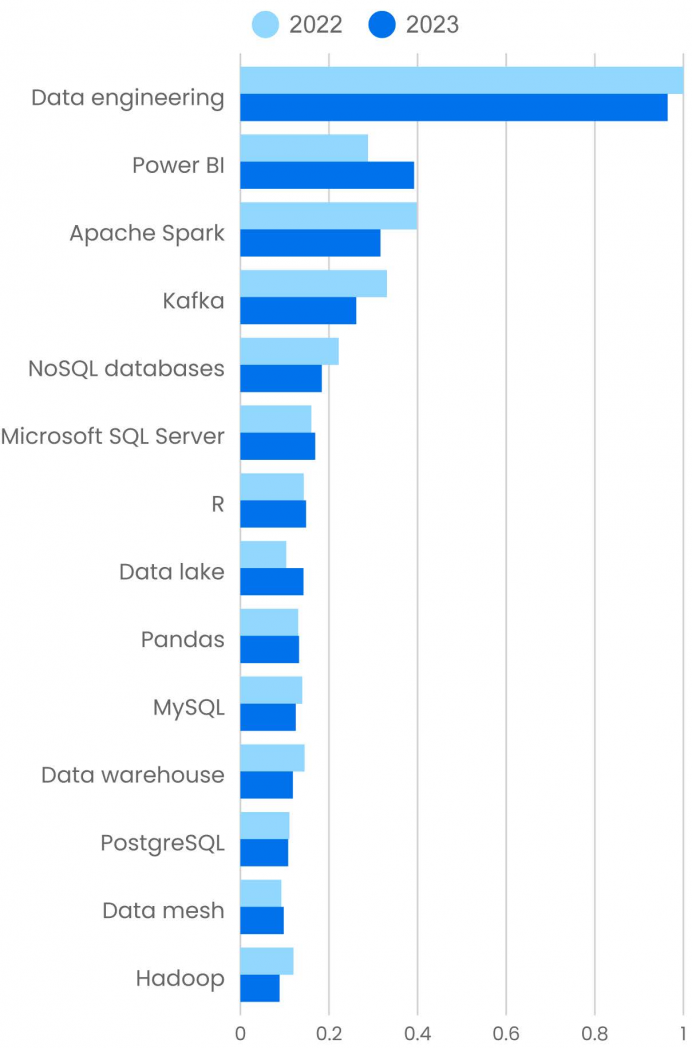
Information engineering used to be through some distance essentially the most closely used subject on this class; it confirmed a three.6% decline, stabilizing after an enormous achieve from 2021 to 2022. Information engineering offers with the issue of storing records at scale and turning in that records to packages. It contains transferring records to the cloud, construction pipelines for obtaining records and getting records to software instrument (continuously in close to genuine time), resolving the problems which might be led to through records siloed in several organizations, and extra. Two of crucial platforms for records engineering, Kafka and Spark, confirmed vital declines in 2023 (21% and 20%, respectively). Kafka and Spark had been workhorses for a few years, however they’re beginning to display their age as they turn into “legacy generation.” (Hadoop, down 26%, is obviously legacy instrument in 2023.) Hobby in Kafka is more likely to upward thrust as AI groups get started enforcing real-time fashions that experience up to date wisdom of exterior records. However we even have to show that there are more moderen streaming platforms (like Pulsar) and more moderen records platforms (like Ray).
Designing enterprise-scale records garage techniques is a core a part of records engineering. Hobby in records warehouses noticed an 18% drop from 2022 to 2023. That’s now not unexpected; records warehouses additionally qualify as legacy generation. Two different patterns for enterprise-scale garage display vital will increase: Utilization of content material about records lakes is up 37% and, in absolute phrases, considerably upper than that of information warehouses. Utilization for records mesh content material is up 5.6%. Each lakes and meshes resolve a fundamental drawback: How do you retailer records in order that it’s simple to get admission to throughout a company with out construction silos which might be handiest related to express teams? Information lakes can come with records in many alternative codecs, and it’s as much as customers to provide construction when records is applied. A records mesh is a actually allotted resolution: every workforce is answerable for its personal records however makes that records to be had during the venture via an interoperability layer. The ones more moderen applied sciences are the place we see enlargement.
The 2 open supply records research platforms have been nearly unchanged in 2023. Utilization of content material about R higher through 3.6%; we’ve already noticed that Python used to be unchanged, and pandas grew through 1.4%. Neither of those goes anyplace, however choices, specifically to pandas, are showing.
Operations
Whether or not you name it operations, DevOps, or one thing else, this box has noticed some necessary adjustments previously yr. We’ve witnessed the upward push of developer platforms, at the side of the linked subject, platform engineering. Either one of the ones are too new to be mirrored in our records: you’ll’t document content material use prior to content material exists. However they’re influencing different subjects.
We’ve mentioned previously that Linux is desk stakes for a task in IT. That’s nonetheless true. However the extra the deployment procedure is automatic—and platform engineering is solely the next move in “Automate All of the Issues”—the fewer builders and IT personnel want to learn about Linux. Device is packaged in boxes, and the boxes themselves run as digital Linux cases, however builders don’t want to know the way to seek out and kill out-of-control processes, do a backup, set up software drivers, or carry out any of the opposite duties which might be the core of machine management. Utilization of content material about Linux is down 6.9%: now not a big alternate however in all probability a mirrored image of the truth that the newest steps ahead in deploying and managing instrument defend other people from direct touch with the working machine.
An identical developments cut back what builders and IT personnel want to learn about Kubernetes, the near-ubiquitous container orchestrator (down 6.9%). Any individual who makes use of Kubernetes is aware of that it’s complicated. We’ve lengthy anticipated “one thing more effective” to come back alongside and exchange it. It hasn’t—however once more, developer platforms put customers a step additional clear of enticing with Kubernetes itself. Wisdom of the main points is encapsulated both in a developer platform or, in all probability extra continuously, in a Kubernetes carrier administered through a cloud supplier. Kubernetes can’t be left out, but it surely’s extra necessary to know high-level ideas than low-level instructions.
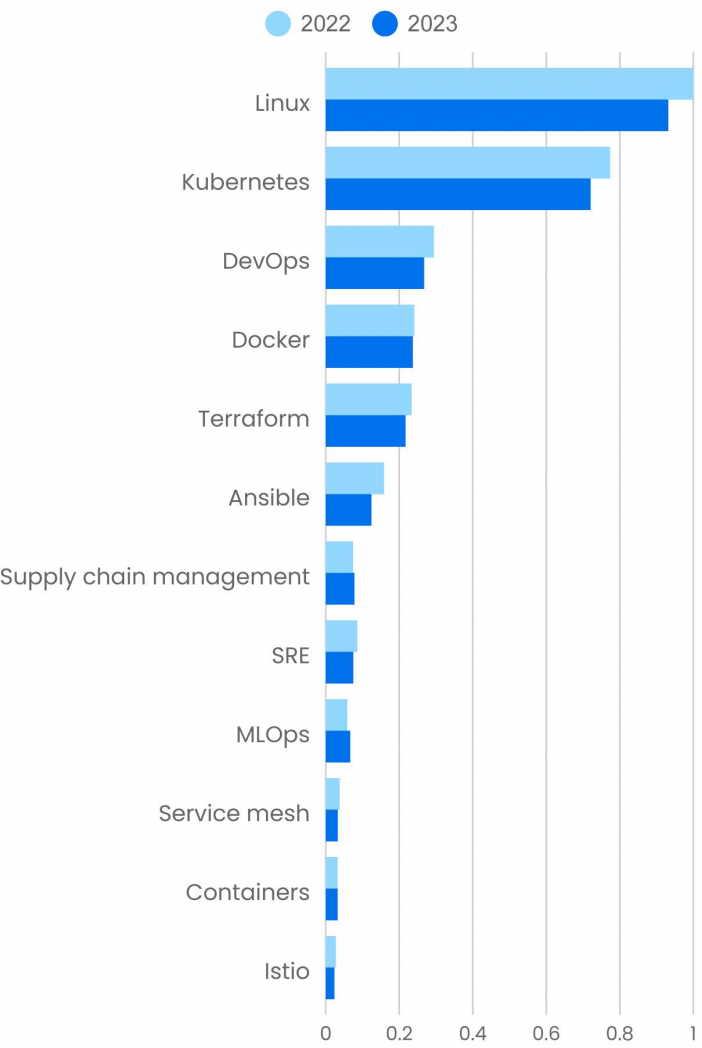
DevOps (9.0%) and SRE (13%) also are down, even though we don’t suppose that’s vital. Phrases come and pass, and those are going. Whilst operations is repeatedly evolving, we don’t imagine we’ll ever get to the legendary state of “NoOps,” nor must we. As a substitute, we’ll see consistent evolution because the ratio of techniques controlled to operations personnel grows ever upper. However we do imagine that quicker moderately than later, any individual will put a brand new identify at the disciplines of DevOps and its shut relative, SRE. That new identify may well be “platform engineering,” even though that time period says extra about designing deployment pipelines than about sporting the pager and maintaining the techniques operating; platform engineering is ready treating builders as shoppers and designing interior developer platforms that make it simple to check and deploy instrument techniques with minimum rite. We don’t imagine that platform engineering subsumes or replaces DevOps. Each are companions in making improvements to revel in for builders and operations personnel (and ratcheting up the ratio of techniques controlled to personnel even upper).
That’s numerous purple ink. What’s within the black? Provide chain control is up 5.9%. That’s now not an enormous build up, however previously few years we’ve been compelled to take into consideration how we organize the instrument provide chain. Any vital software simply has dozens of dependencies, and every of the ones dependencies has its personal dependencies. The full collection of dependencies, together with each direct and inherited dependencies, can simply be masses and even 1000’s. Malicious operators have came upon that they may be able to corrupt instrument archives, getting programmers to inadvertently incorporate malware into their instrument. Sadly, safety issues by no means in reality pass away; we think instrument provide chain safety to stay a very powerful factor for the foreseeable (and unforeseeable) long term.
We’ve already discussed that MLOps, the self-discipline of deploying and managing fashions for system studying and synthetic intelligence, is up 14%. System studying and AI constitute a brand new roughly instrument that doesn’t observe conventional laws, so conventional approaches to operations don’t paintings. The checklist of variations is lengthy:
- Whilst maximum approaches to deployment are in accordance with the concept an software will also be reproduced from a supply archive, that isn’t true for AI. An AI machine is dependent as a lot at the coaching records because it does at the supply code, and we don’t but have excellent equipment for archiving coaching records.
- Whilst we’ve mentioned that open supply fashions equivalent to Alpaca are a lot smaller than fashions like GPT-4 or Google’s Gemini, even the smallest of the ones fashions could be very massive through any affordable same old.
- Whilst we’ve gotten used to automatic trying out as a part of a deployment pipeline, AI fashions aren’t deterministic. A take a look at doesn’t essentially give the similar consequence each time it runs. Checking out isn’t any much less necessary for AI than it’s for normal instrument (arguably it’s extra necessary), and we’re beginning to see startups constructed round AI trying out, however we’re nonetheless at first.
That’s only a get started. MLOps is a badly wanted area of expertise. It’s excellent to look rising pastime.
Safety
Nearly all branches of safety confirmed enlargement from 2022 to 2023. That’s a welcome alternate: within the fresh previous, many corporations mentioned safety however by no means made the funding had to protected their techniques. That’s converting, for causes which might be glaring to somebody who reads the scoop. No one needs to be a sufferer of information robbery or ransomware, specifically now that ransomware has developed into blackmail.
The demanding situations are in reality quite simple. Community safety, maintaining intruders off of your community, used to be essentially the most broadly used subject and grew 5%. Firewalls, that are a very powerful element of community safety, grew 16%. Hardening, a way smaller subject that addresses making techniques much less susceptible to assault, grew 110%. Penetration trying out remained one of the crucial broadly used subjects. Utilization dropped 5%, despite the fact that a ten% build up for Kali Linux (a very powerful software for penetration testers) in large part offsets that decline.
The 22% enlargement in safety governance is every other indicator of modified attitudes: safety is now not an advert hoc workout that waits for one thing to occur after which fights fires. Safety calls for making plans, coaching, trying out, and auditing to make certain that insurance policies are efficient.
One key to safety is understanding who your customers are and which portions of the machine every person can get admission to. Identification and get admission to control (IAM) has continuously been recognized as a weak point, specifically for cloud safety. As techniques develop extra complicated, and as our thought of “id” evolves from folks to roles assigned to instrument products and services, IAM turns into a lot more than usernames and passwords. It calls for a radical working out of who the actors are to your techniques and what they’re allowed to do. This extends the previous thought of “least privilege”: every actor wishes the facility to do just what they want, not more and no much less. Using content material about IAM grew 8.0% previously yr. It’s a smaller achieve than we might have preferred to look however now not insignificant.
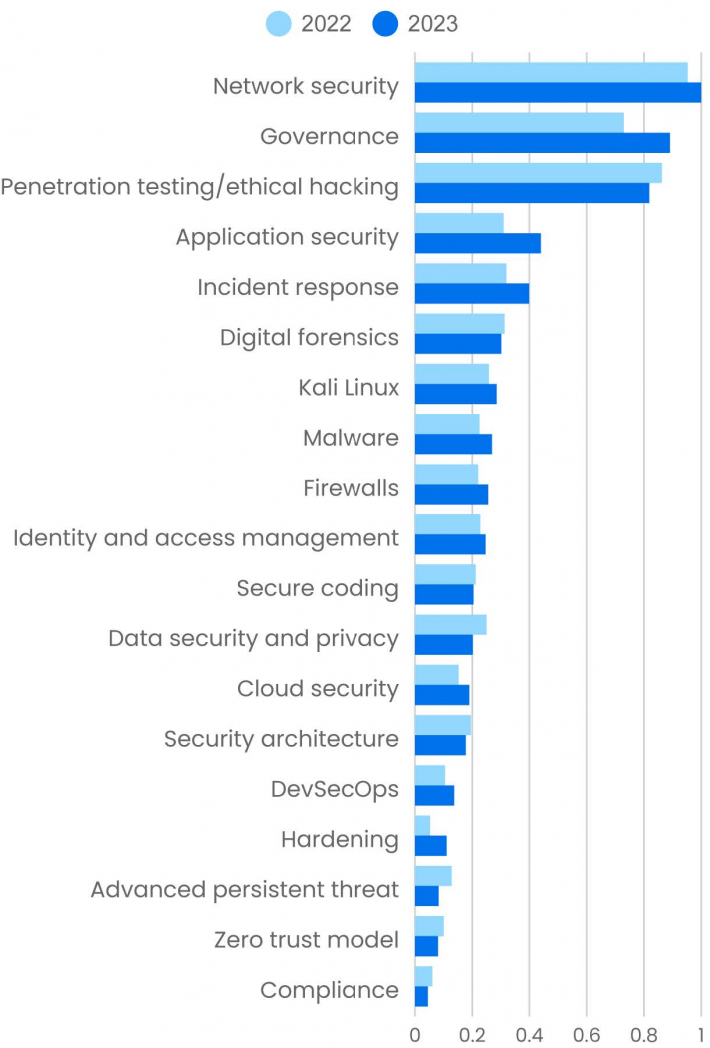
Software safety grew 42%, appearing that instrument builders and operations personnel are getting the message. The DevSecOps “shift left” motion, which specializes in instrument safety early within the building procedure, seems to be profitable; use of content material about DevSecOps used to be up 30%. In a similar fashion, those that deploy and deal with packages have turn into much more acutely aware of their duties. Builders would possibly design id and get admission to control into the code, however operations is answerable for configuring those appropriately and making sure that get admission to to packages is handiest granted accurately. Safety can’t be added after the truth; it needs to be a part of the instrument procedure from starting to the tip.
Complex power threats (APTs) have been all over the place the scoop a couple of years in the past. We don’t see the time period APT anyplace close to up to we used to, so we’re now not stunned that utilization has dropped through 35%. Nonetheless, geographical regions with refined offensive features are very genuine, and cyber war is a very powerful element of a number of world conflicts, together with the battle in Ukraine.
It’s disappointing to look that utilization of content material about 0 agree with has declined through 20%. That lower is greater than offset through the rise in IAM, which is an very important software for 0 agree with. However don’t omit that IAM is only a software and that the objective is to construct techniques that don’t depend on agree with, that at all times test that each actor is accurately recognized and licensed. How are you able to protect your IT infrastructure for those who suppose that attackers have already got get admission to? That’s the query 0 agree with solutions. Consider not anything; test the entirety.
After all, compliance is down 27%. That’s greater than offset through the considerable build up of pastime in governance. Auditing for compliance is unquestionably part of governance. Specializing in compliance itself, with out making an allowance for the bigger image, is an issue moderately than an answer. We’ve noticed many corporations that target compliance with present requirements and rules whilst warding off the laborious paintings of inspecting possibility and growing efficient insurance policies for safety. “It isn’t our fault that one thing unhealthy came about; we adopted the entire laws” is, at best possible, a deficient means to provide an explanation for systemic failure. If that compliance-oriented mindset is fading, excellent riddance. Compliance, understood correctly, is a very powerful element of IT governance. Understood badly, compliance is an unacceptable excuse.
After all, a phrase about an issue that doesn’t but seem in our records. There has, after all, been numerous chatter about using AI in safety packages. AI shall be an excellent asset for log record research, intrusion detection, incident reaction, virtual forensics, and different sides of cybersecurity. However, as we’ve already mentioned, there are at all times two facets to AI. How does AI alternate safety itself? Any group with AI packages may have to offer protection to them from exploitation. What vulnerabilities does AI introduce that didn’t exist a couple of years in the past? There are lots of articles about recommended injection, sneaky activates designed to “jailbreak” AI techniques, records leakage, and different vulnerabilities—and we imagine that’s handiest the start. Securing AI techniques shall be a serious subject within the coming years.
Cloud Computing
Having a look at platform utilization for cloud-related subjects, something sticks out: cloud local. No longer handiest is it essentially the most broadly used subject in 2023, but it surely grew 175% from 2022 to 2023. This marks an actual transition. Prior to now, corporations constructed instrument to run on-premises after which moved it to the cloud as vital. Regardless of stories (together with ours) that confirmed 90% or extra “cloud adoption,” we at all times felt that used to be very positive. Positive, 90% of all corporations will have one or two experiments in the cloud—however are they in reality construction for the cloud? This large surge in cloud local building displays that we’ve now crossed that chasm and that businesses have stopped kicking the tires. They’re construction for the cloud as their number one deployment platform.
You need to, after all, draw the other conclusion through taking a look at cloud deployment, which is down 27%. If corporations are growing for the cloud, how are the ones packages being deployed? That’s an even query. Then again, as cloud utilization grows, so does organizational wisdom of cloud-related subjects, specifically deployment. As soon as an IT workforce has deployed its first software, the second one isn’t essentially “simple” or “the similar,” however it’s acquainted. At this level within the historical past of cloud computing, we’re seeing few whole inexperienced persons. As a substitute we’re seeing present cloud customers deploying increasingly more packages. We’re additionally seeing a upward thrust in equipment that streamline cloud deployment. Certainly, any supplier value fascinated with has an amazing pastime in making deployment so simple as imaginable.
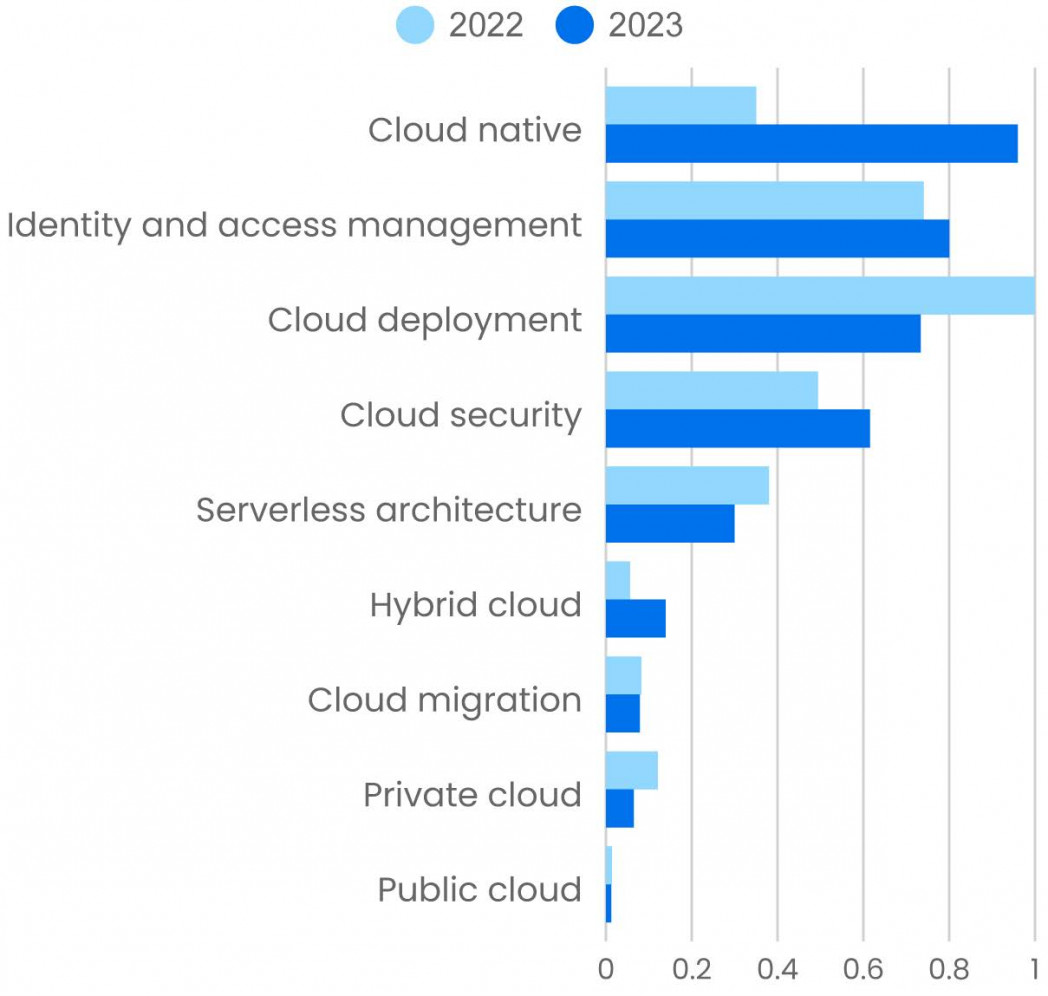
Use of content material about cloud safety grew 25%, and id and get admission to control (IAM) grew 8%. A virulent disease of information robbery and ransomware that continues to nowadays put safety at the company map as a concern, now not simply an expense with annual price range requests that gave the impression of an extortion rip-off: “Not anything unhealthy came about this yr; give us extra money and possibly not anything unhealthy will occur subsequent yr.” And whilst the basis of any safety coverage is excellent native safety hygiene, it’s additionally true that the cloud items its personal problems. Identification and get admission to control: in the neighborhood, that suggests passwords, key playing cards, and (most certainly) two-factor authentication. Within the cloud, that suggests IAM, at the side of 0 agree with. Identical thought, however it will be irresponsible to suppose that those aren’t harder within the cloud.
Hybrid cloud is a smaller subject space that has grown considerably previously yr (145%). This enlargement issues in part to the cloud changing into the de facto deployment platform for venture packages. It additionally recognizes the truth of the way cloud computing is followed. Years in the past, when “the cloud” used to be getting began, it used to be simple for a couple of builders in R&D to expense a couple of hours of time on AWS moderately than requisitioning new {hardware}. The similar used to be true for data-aware entrepreneurs who sought after to research what used to be taking place with their attainable shoppers—and they would make a selection Azure. When senior control in any case aroused from sleep to the desire for a “cloud technique,” they have been already in a hybrid state of affairs, with more than one wildcat tasks in more than one clouds. Mergers and buyouts sophisticated the placement extra. If corporate A is essentially the usage of AWS and corporate B has invested closely in Google Cloud, what occurs after they merge? Unifying at the back of a unmarried cloud supplier isn’t going to be value it, despite the fact that cloud suppliers are offering equipment to simplify migration (concurrently they make their very own clouds tricky to go away). The cloud is of course hybrid. “Non-public cloud” and “public cloud,” when located as choices to one another and to a hybrid cloud, scent like “final yr’s information.” It’s now not unexpected that utilization has dropped 46% and 10%, respectively.
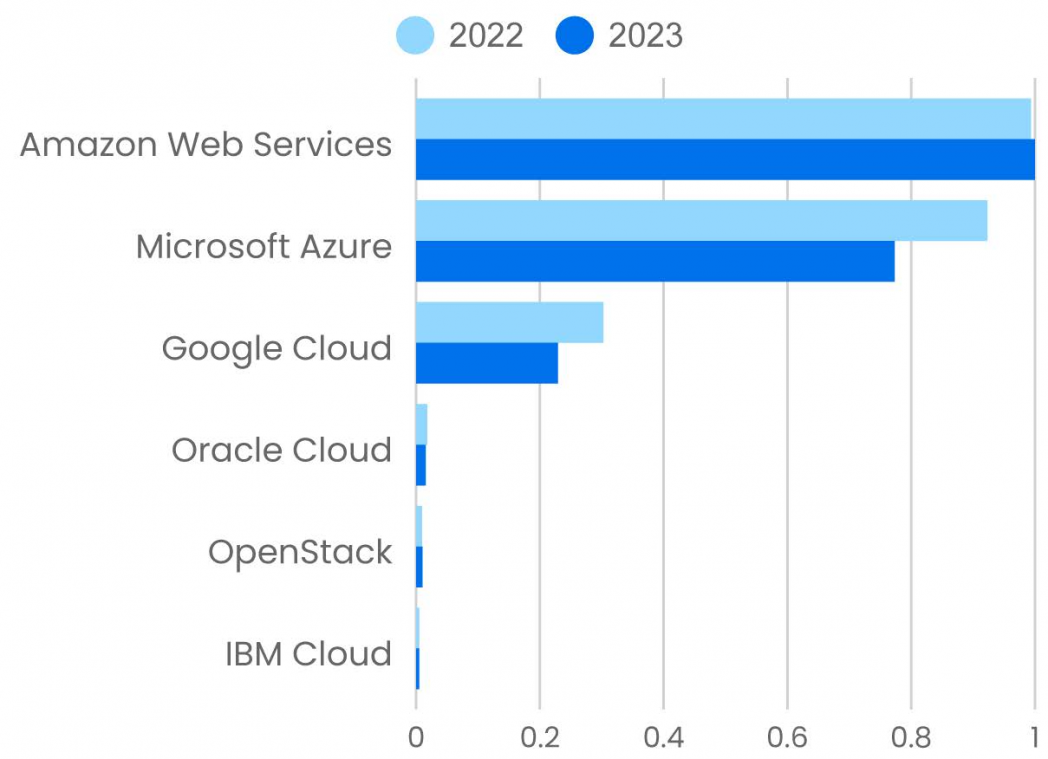
What concerning the perennial horse race between Amazon Internet Services and products, Microsoft Azure, and Google Cloud? Is somebody nonetheless , apart from in all probability traders and analysts? AWS confirmed an overly, very small achieve (0.65%), however Azure and Google Cloud confirmed vital losses (16% and 22%, respectively). We anticipated to look Azure catch as much as AWS as a result of its lead in AI as a carrier, but it surely didn’t. So far as our platform is worried, that’s nonetheless sooner or later.
Internet Building
React and Angular proceed to dominate cyber web building. JavaScript continues to be the lingua franca of cyber web building, and that isn’t more likely to alternate any time quickly.
However the utilization trend has modified reasonably. Remaining yr, React used to be up, and Angular used to be sharply down. This yr, utilization of React content material hasn’t modified considerably (down 0.33%). Angular is down 12%, a smaller decline than final yr however nonetheless vital. When a platform is as dominant as React, it will have nowhere to move however down. Is momentum transferring?
We see some fascinating adjustments some of the much less widespread frameworks, each previous and new. First, Vue isn’t a big a part of the full image, and it isn’t new—it’s been round since 2014—but when its 28% annual enlargement continues, it’s going to quickly turn into a dominant framework. That build up represents a cast turnaround after shedding 17% from 2021 to 2022. Django is even older (created in 2005), but it surely’s nonetheless broadly used—and with an 8% build up this yr, it’s now not going away. FastAPI is the most recent of this workforce (2018). Despite the fact that it accounts for an overly small share of platform use, it’s simple for a small alternate in utilization to have a big impact. An 80% build up is difficult to forget about.
It’s value taking a look at those frameworks in just a little extra element. Django and FastAPI are each Python-based, and FastAPI takes complete good thing about Python’s sort hinting characteristic. Python has lengthy been an also-ran in cyber web building, which has been ruled through JavaScript, React, and Angular. May just that be converting? It’s laborious to mention, and it’s value noting that Flask, every other Python framework, confirmed a 12% lower. As a complete, Python frameworks most certainly declined from 2022 to 2023, however that is probably not the tip of the tale. Given the collection of boot camps coaching new cyber web programmers in React, the JavaScript hegemony shall be laborious to triumph over.
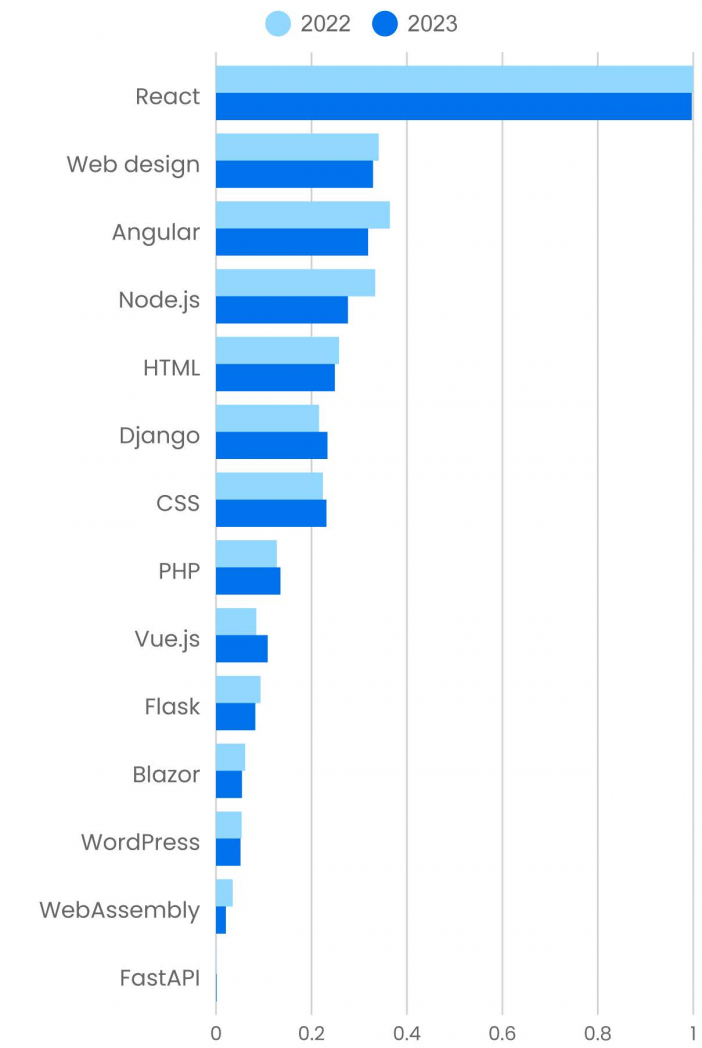
What about PHP, every other long-standing framework that dates again to 1995, when the cyber web used to be certainly younger? PHP grew 5.9% previously yr. Using content material about PHP is small in comparison to frameworks like React and Angular and even Django. PHP unquestionably doesn’t encourage the joy that it did within the Nineteen Nineties. However keep in mind that over 80% of the cyber web is constructed on PHP. It’s by no means stylish, it’s now not able to construction the feature-rich websites that many customers be expecting—but it surely’s in all places. WordPress (down 4.8%), a content material control machine used for thousands and thousands of web sites, is in accordance with PHP. However without reference to the collection of websites which might be constructed on PHP or WordPress, Certainly displays kind of thrice as many process openings for React builders as for PHP and WordPress mixed. PHP unquestionably isn’t going away, and it will also be rising reasonably. However we suspect that PHP programmers spend maximum in their time keeping up older websites. They already know what they want to do this, and neither of the ones elements drives content material utilization.
What about any other extremely buzzworthy applied sciences? After appearing 74% enlargement from 2021 to 2022, WebAssembly (Wasm) declined through 41% in 2023. Blazor, a cyber web framework for C# that generates code for Wasm, declined through 11%. Does that imply that Wasm is death? We nonetheless imagine Wasm is an important generation, and we incessantly examine wonderful tasks which might be constructed with it. It isn’t but a mature generation—and there are many builders prepared to argue that there’s no use for it. We would possibly disagree, however that misses the purpose. Utilization of Wasm content material will most certainly decline step by step…till any individual creates a killer software with it. Will that occur? Most definitely, however we will be able to’t wager when.
What does this imply for any individual who’s looking to broaden their abilities as a cyber web developer? First, you continue to can’t pass unsuitable with React, and even with Angular. The opposite JavaScript frameworks, equivalent to Subsequent.js, also are excellent choices. Many of those are metaframeworks constructed on React, so understanding them makes you extra flexible whilst leveraging wisdom you have already got. In the event you’re taking a look to expand your abilities, Django can be a profitable addition. It’s an overly succesful framework, and understanding Python will open up different probabilities in instrument building that can be useful sooner or later, even supposing now not now.
Certification
This yr, we took a unique strategy to certification. Relatively than discussing certification for various matter spaces one after the other (this is, cloud certification, safety certification, and many others.), we used records from the platform to construct an inventory of the highest 20 certifications and grouped them in combination. That procedure provides a reasonably other image of which certifications are necessary and why. We additionally took a temporary have a look at O’Reilly’s new badges program, which supplies every other viewpoint on what our shoppers wish to study.
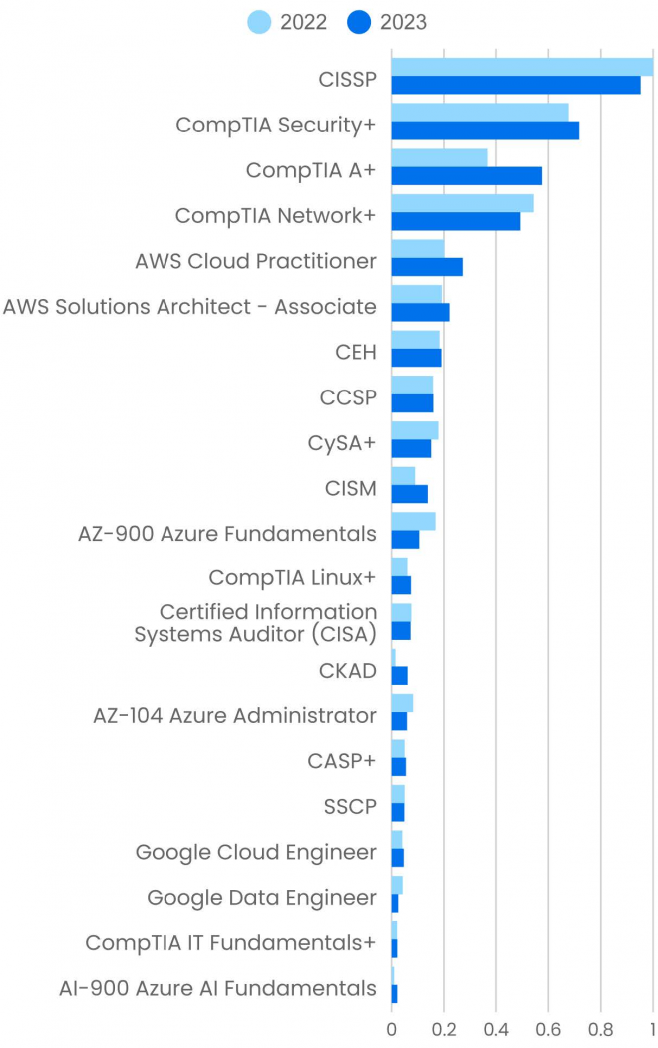
In line with the use of content material in our platform (together with observe assessments), the most well liked certifications are safety certifications: CISSP (which declined 4.8%) and CompTIA Safety+ (which grew 6.0%). CISSP is an in-depth examination for safety execs, requiring no less than 5 years’ revel in prior to taking the examination. Safety+ is extra of an entry-level examination, and its enlargement displays that safety personnel are nonetheless in call for. ISACA’s Qualified Knowledge Safety Supervisor (CISM) examination, which specializes in possibility overview, governance, and incident reaction, isn’t as widespread however confirmed a 54% build up. CompTIA’s Qualified Complex Safety Practitioner (CASP+) confirmed a ten% build up—now not as massive however a part of the similar pattern. The Qualified Moral Hacker (CEH) examination, which specializes in tactics helpful for penetration trying out or red-teaming, is up 4.1%, after a decline final yr. The ones will increase replicate the place control is making an investment. Hoping that there gained’t be an incident has been changed through working out publicity, putting in governance mechanisms to reduce possibility, and with the ability to reply to incidents after they happen.
What in reality sticks out, then again, isn’t safety: it’s the higher use of content material about CompTIA A+, which is up 58%. A+ isn’t a safety examination; it’s marketed as an entry-level examination for IT strengthen, stressing subjects like working techniques, managing SaaS for faraway paintings, troubleshooting instrument, {hardware}, and networking issues, and the like. It’s testimony to the huge quantity of people that wish to get into IT. Utilization of content material concerning the CompTIA Linux+ examination used to be a lot decrease but in addition grew sharply (23%)—and, as we’ve mentioned previously, Linux is “desk stakes” for nearly any process in computing. It’s much more likely that you simply’ll stumble upon Linux not directly by way of boxes or cloud suppliers moderately than managing racks of computer systems operating Linux; however you are going to be anticipated to comprehend it. The Qualified Kubernetes Administrator (CKAD) examination additionally confirmed vital enlargement (32%). Because it used to be first launched in 2014, Kubernetes has turn into an inescapable a part of IT operations. The most important pattern in IT, going again 70 years or so, has been the rise within the ratio of machines to operators: from more than one operators according to system within the ’60s to at least one operator according to system within the technology of minicomputers to dozens and now, within the cloud, to masses and 1000’s. Advanced as Kubernetes is—and we admit, we stay searching for a more effective selection—it’s what we could IT teams organize massive packages which might be carried out as dozens of microservices and that run in 1000’s of boxes on an uncountable collection of digital machines. Kubernetes has turn into an very important ability for IT. And certification is changing into increasingly more sexy to other people running within the box; there’s no different space wherein we see such a lot enlargement.
Cloud certifications additionally display prominently. Even if “the cloud” has been round for nearly two decades, and virtually each corporate will say that they’re “within the cloud,” if truth be told many corporations are nonetheless making that transition. Moreover, cloud suppliers are repeatedly including new products and services; it’s a box the place maintaining with alternate is tricky. Content material about Amazon Internet Services and products used to be most generally used. AWS Cloud Practitioner higher through 35%, adopted through AWS Answers Architect (Affiliate), which higher 15%. Microsoft Azure certification content material adopted, even though the 2 maximum outstanding tests confirmed a decline: Azure Basics (AZ-900) used to be down 37%, and Azure Management (AZ-104) used to be down 28%. Google Cloud certifications trailed the remaining: Google’s Cloud Engineer confirmed cast enlargement (14%), whilst its Information Engineer confirmed an important decline (40%).
Content material about Microsoft’s AI-900 examination (Azure AI Basics) used to be the least-used some of the certifications that we tracked. Then again, it won 121%—it greater than doubled—from 2022 to 2023. Whilst we will be able to’t expect subsequent yr, that is one of these alternate that developments are fabricated from. Why did this examination all at once get so scorching? It’s simple, in reality: Microsoft’s funding in OpenAI, its integration of the GPT fashions into Bing and different merchandise, and its AI-as-a-service choices via Azure have all at once made the corporate a pacesetter in cloud-based AI. Whilst we typically hedge our bets on smaller subjects with large annual enlargement—it’s simple for a unmarried new direction or e book to motive a big swing—AI isn’t going away, neither is Microsoft’s management in cloud products and services for AI builders.
Overdue in 2023, O’Reilly started to supply badges tied to direction of completion at the O’Reilly studying platform. Badges aren’t certifications, however taking a look on the peak badges provides every other tackle what our shoppers are eager about studying. The effects aren’t unexpected: Python, GPT (now not simply ChatGPT), Kubernetes, instrument structure, and Java are the most well liked badges.
Then again, it’s fascinating to have a look at the variation between our B2C shoppers (shoppers who’ve purchased platform subscriptions as folks) and B2B shoppers (who use the platform by way of a company subscription). For many subjects, together with the ones indexed above, the ratio of B2B to B2C shoppers is within the vary of two:1 or 3:1 (two or thrice as many company shoppers as folks). The outliers are for subjects like communications abilities, Agile, Scrum, non-public productiveness, Excel, and presentation abilities: customers from B2B accounts bought those badges 4 (or extra) occasions as continuously as customers with non-public accounts. This is smart: those subjects are about teamwork and different abilities which might be treasured in a company atmosphere.
There are few (if any) badge subjects for which person (B2C) customers outnumbered company shoppers; that’s only a mirrored image of our buyer base. Then again, there have been some subjects the place the ratio of B2B to B2C shoppers used to be nearer to at least one. Probably the most fascinating of those involved synthetic intelligence: massive language fashions (LLMs), TensorFlow, herbal language processing, LangChain, and MLOps. Why is there extra pastime amongst folks than amongst company shoppers? Most likely through subsequent yr we’ll know.
Design
The necessary tale in design is ready equipment. Subjects like person revel in and cyber web design are solid or reasonably down (down 0.62% and three.5%, respectively). However utilization about design equipment is up 105%, and the VC unicorn Figma is up 145%. Triple-digit enlargement most certainly gained’t proceed, but it surely’s unquestionably value noticing. It highlights two necessary developments that transcend conventional design subjects, like UX.
First, low-code and no-code equipment aren’t new, however many new ones have seemed previously yr. Their luck has been aided through synthetic intelligence. We have already got AI equipment that may generate textual content, whether or not for a manufacturing website or for a mockup. Quickly we’ll have no-code equipment that don’t simply spit out a wireframe however will have the ability to enforce the design itself. They’re going to be good about what the person needs them to do. However to know the significance of low-code to design, it’s a must to glance past the use designers will make of those equipment. Designers may also be designing those equipment, at the side of different AI-powered packages. Equipment for designers need to be well-designed, after all: that’s trivial. However what many discussions about AI forget about is that designing packages that use AI properly is some distance from trivial. We’ve all been blindsided through the luck of ChatGPT, which made the GPT fashions in an instant available to everybody. However as soon as you get thinking about the probabilities, you understand {that a} chat is hardly ever a really perfect interface for an AI machine.2 What is going to the customers of those techniques in reality want? We’ve handiest simply began down that trail. It’s going to be a thrilling adventure—specifically for designers.
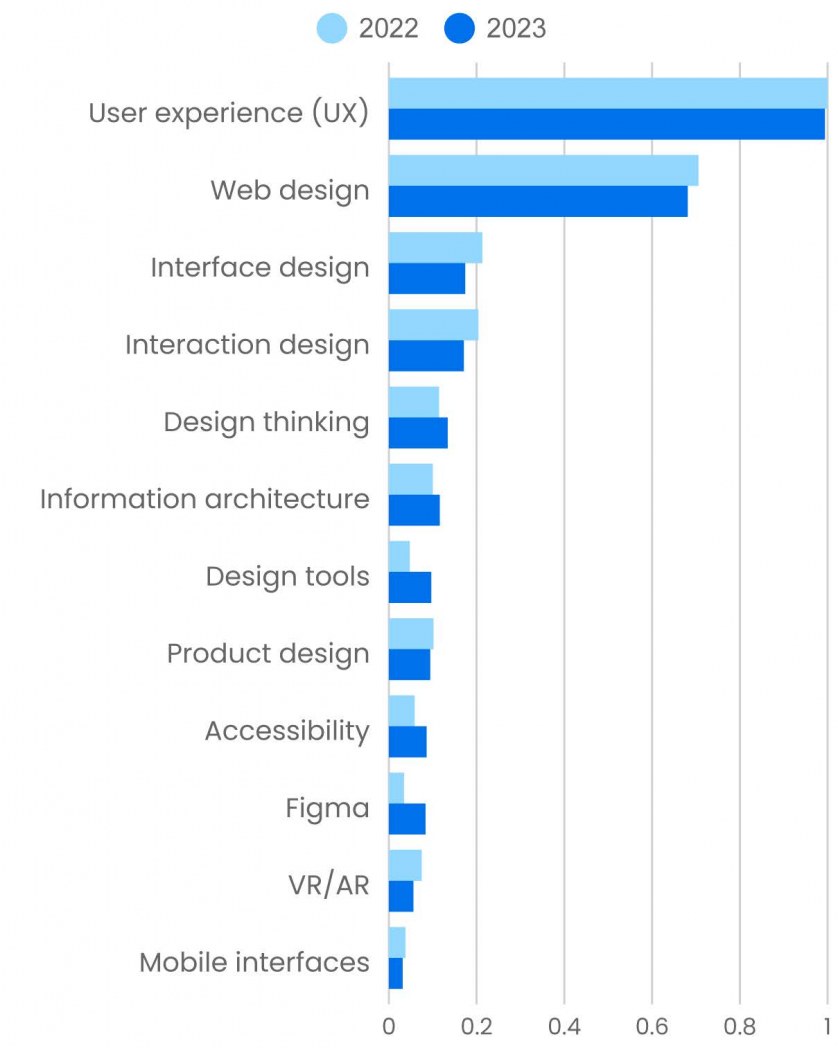
2d, Figma is necessary as it’s a step forward in equipment for collaboration. Equipment that let faraway staff to collaborate productively are the most important when coworkers will also be anyplace: in an place of work, at house, or on every other continent. The final yr and a 1/2 has been filled with speak about digital truth, metaverses, and the like. However what few have discovered is that the metaverse isn’t about dressed in goggles—it’s about seamless collaboration with pals and coworkers. Use of content material about AR and VR dropped 25% as a result of other people have overlooked the true tale: we don’t want 3-D goggles; we’d like equipment for collaboration. And, as with low-code, collaboration equipment are each one thing to design with and one thing that must be designed. We’re at the fringe of a brand new means to have a look at the sector.
Use of content material about knowledge structure used to be up 16%, improving from its decline from 2021 to 2022. The want to provide knowledge properly, to design the environments wherein we eat knowledge on-line, hasn’t ever been extra necessary. On a daily basis, there’s additional info to soak up and to navigate—and whilst synthetic intelligence will undoubtedly lend a hand with that navigation, AI is as a lot a design drawback as a design resolution. (Even though it’s a “excellent drawback” to have.) Designing and construction for accessibility is obviously associated with knowledge structure, and it’s excellent to look extra engagement with that content material (up 47%). It’s been a very long time coming, and whilst there’s nonetheless a protracted method to pass, accessibility is being taken extra significantly now than previously. Web pages which might be designed to be usable through other people with impairments aren’t but the guideline, however they’re now not exceptions.
Skilled Building
Nearly everybody concerned with instrument begins as a programmer. However that’s infrequently the place they finish. In the future of their profession, they’re requested to jot down a specification, lead a workforce, organize a bunch, or possibly even discovered an organization or function an govt in an present corporate.
O’Reilly is the final corporate to imagine that instrument builders are neck-bearded geeks who need not anything greater than to are living in a cave and sort on their terminals. We’ve spent maximum of our historical past preventing towards that stereotype. Nonetheless, going past instrument building is a widespread supply of tension. That’s undoubtedly true for somebody stepping outdoor their convenience zone in on the subject of any box, whether or not it’s accounting, legislation, medication, or one thing else. However someday to your profession, it’s a must to do one thing that you simply aren’t ready to do. And, in truth, the most productive leaders are most often those who’ve some nervousness, now not those whose response is “I used to be born to be a pacesetter.”
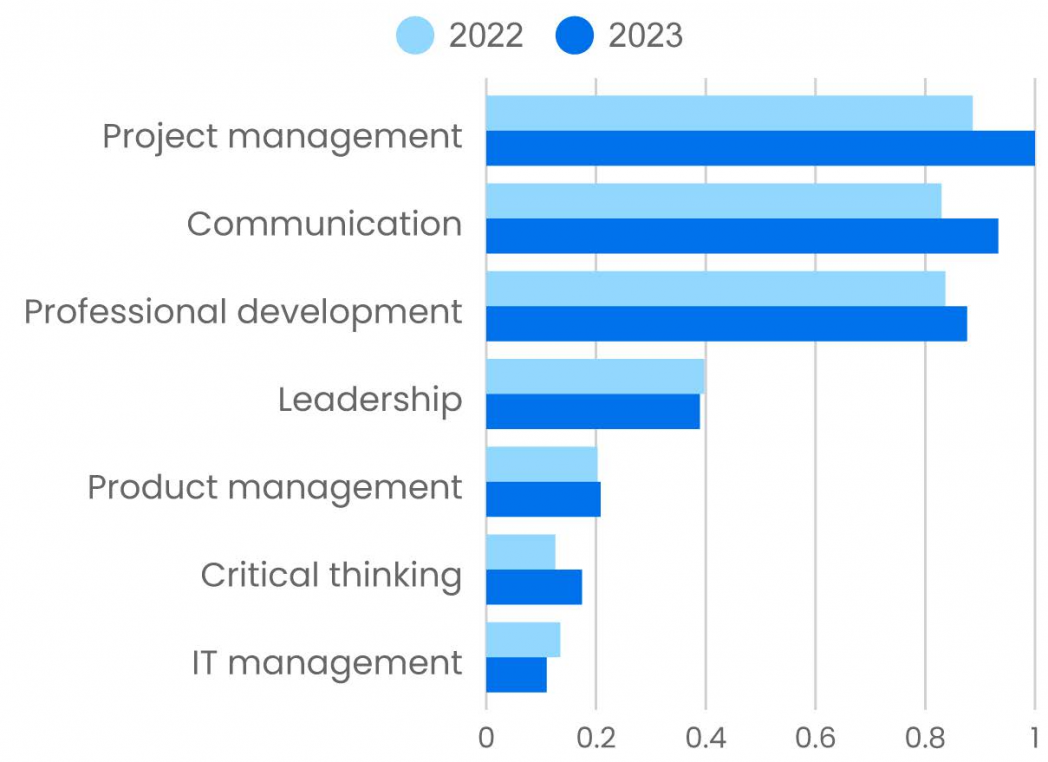
For the previous few years, our target market has been eager about skilled enlargement that is going past simply writing instrument or construction fashions for AI and ML. Challenge control is up 13%; the facility to control massive tasks is obviously noticed as an asset for workers who’re searching for their subsequent promotion (or, in some circumstances, their subsequent process). No matter their targets may well be, somebody searching for a promotion or a brand new process—and even simply solidifying their grasp on their present process—can be properly served through making improvements to their communications abilities (up 23%). Skilled building (up 22%) is a catch-all subject that seems to be responding to the similar wishes. What’s riding this? 2023 started and ended with numerous information about layoffs. However in spite of well-publicized layoffs from large corporations that overhired throughout the pandemic, there’s little proof that the business as a complete has suffered. People who find themselves laid off appear to be snapped up briefly through new employers. Nonetheless, nervousness is genuine, and the emphasis we’re seeing on skilled building (and in particular, communications and mission control abilities) is partly a results of that nervousness. Any other a part of the tale is undoubtedly the way in which AI is converting the administrative center. If generative AI makes other people extra environment friendly, it frees up time for them to do different issues, together with strategic fascinated with product building and management. It’s going to in any case be time to worth “folks and interactions over processes and equipment,” and “buyer collaboration over contract negotiation,” because the Agile Manifesto claims. Doing so would require a certain quantity of reeducation, that specialize in spaces like communications, interpersonal abilities, and strategic pondering.
Product control, the self-discipline of managing a product’s lifecycle from the preliminary thought via building and unencumber to the marketplace, could also be a fascinating ability. So why is it handiest up 2.8% and now not 20% like mission control? Product control is a more moderen place in maximum corporations; it has robust ties to advertising and marketing and gross sales, and so far as concern of layoffs is worried (whether or not genuine or media pushed), product control positions is also perceived as extra prone.
A have a look at the ground of the chart displays that utilization of content material that teaches serious pondering grew 39%. That may be partially a outcome of ChatGPT and the explosion in synthetic intelligence. We all know that AI techniques make errors, and virtually each article that discusses those errors talks concerning the want for serious pondering to research AI’s output and to find mistakes. Is that the motive? Or is the need for higher serious pondering abilities simply every other side {of professional} enlargement?
A Odd Yr?
Again at first, I mentioned this used to be a atypical yr. Up to we adore to discuss the velocity at which generation strikes, truth most often doesn’t transfer that rapid. When did we first get started speaking about records? Tim O’Reilly mentioned “Information is the following Intel Inside of” in 2005, virtually two decades in the past. Kubernetes has been round for a decade, and that’s now not counting its prehistory as Google’s Borg. Java used to be presented in 1995, virtually 30 years in the past, and that’s now not counting its set-top field prehistory as Oak and Inexperienced. C++ first seemed in 1985. Synthetic intelligence has a prehistory so long as computing itself. When did AI emerge from its wintry cave to dominate the information science panorama? 2016 or 2017, once we have been amazed through systems that would type pictures into canines and cats? Positive, Java has modified so much; so has what we do with records. Nonetheless, there’s extra continuity than disruption.
This yr used to be some of the few years that would in fact be referred to as disruptive. Generative AI will alternate this business in necessary tactics. Programmers gained’t turn into out of date, however programming as we comprehend it would possibly. Programming may have extra to do with working out issues and designing excellent answers than specifying, step by step, what a pc must do. We’re now not there but, however we will be able to unquestionably believe an afternoon when a human language description leads reliably to running code, when “Do what I supposed, now not what I mentioned” ceases to be the programmer’s curse. That fluctuate has already begun, with equipment like GitHub Copilot. However to thrive in that new business, programmers will want to know extra about structure, extra about design, extra about human members of the family—and we’re handiest beginning to see that during our records, essentially for subjects like product control and communications abilities. And in all probability that’s the definition of “disruptive”: when our techniques and our expectancies alternate sooner than our talent to take care of. I’m now not fearful about programmers “shedding their jobs to an AI,” and I in reality don’t see that fear some of the many programmers I communicate to. However no matter occupation you’re in, you are going to lose out for those who don’t stay up. That isn’t type or humane; that’s capitalism. And in all probability I must have used ChatGPT to jot down this document.3
Jerry Lee Lewis would possibly have mentioned “There’s a complete lotta disruption goin’ on.” However in spite of all this disruption, a lot of the business stays unchanged. Other folks appear to have bored with the phrases DevOps and SRE, however so it is going: the half-life of a buzzword is inevitably brief, and those had been extremely long-lived. The issues those buzzwords constitute haven’t long gone away. Even if we aren’t but amassing the information (and don’t but have sufficient content material for which to gather records), developer platforms, self-service deployment, and platform engineering seem like the next move within the evolution of IT operations. Will AI play a job in platform engineering? We’d be stunned if it didn’t.
Motion to the cloud continues. Whilst we’ve heard communicate of cloud “repatriation,” we see no proof that it’s taking place. We do see proof that organizations understand that the cloud is of course hybrid and that that specialize in a unmarried cloud supplier is short-sighted. There’s additionally proof that organizations are actually paying greater than lip carrier to safety, specifically cloud safety. That’s an excellent signal, particularly after a few years wherein corporations approached safety through hoping not anything unhealthy would occur. As many chess grandmasters have mentioned, “Hope isn’t a excellent technique.”
Within the coming yr, AI’s disruption will proceed to play out. What penalties will it have for programming? How will jobs (and process potentialities) alternate? How will IT adapt to the problem of managing AI packages? Will they depend on AI-as-a-service suppliers like OpenAI, Azure, and Google, or will they construct on open supply fashions, which can most certainly run within the cloud? What new vulnerabilities will AI packages introduce into the protection panorama? Do we see new architectural patterns and types? Will AI equipment for instrument structure and design lend a hand builders grapple with the difficulties of microservices, or will it simply create confusion?
In 2024, we’ll face all of those questions. Most likely we’ll begin to see solutions. Something is obvious: it’s going to be a thrilling yr.
Footnotes
- Google Developments suggests that we is also seeing a resurgence in ChatGPT searches. In the meantime, searches for ChatGPT on our platform seem to have bottomed out in October, with an overly slight build up in November. This discrepancy aligns properly with the variation between our platform and Google’s. If you wish to use ChatGPT to jot down a time period paper, are you going to look Google or O’Reilly?
- Phillip Carter’s article, “All of the Exhausting Stuff No one Talks About when Construction Merchandise with LLMs,” is value studying. Whilst it isn’t in particular about design, virtually the entirety he discusses is one thing designers must take into consideration.
- I didn’t. No longer even for records research.

